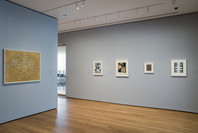Mondrian's abstracted pier—the vertical lines at the base of the oval—stretches into an ocean of short lines and crosses that suggest flickering light on the surface of water. The artist forged his approach to abstraction through Cubism, which he encountered during the two years he lived in Paris, from 1912 to 1914. He said, "I wish to approach truth as closely as is possible, and therefore I abstract everything until I arrive at the fundamental quality of objects."
Gallery label from Geo/Metric: Prints and Drawings from the Collection, June 11–August 18, 2008.
After returning to Holland for a vacation in 1914, Mondrian found to his chagrin that the outbreak of World War I would prevent his return to Paris until the conflict was over. Marooned in his homeland, he began to explore new methods of paring down and distilling a motif. In this drawing he transforms the thrust of a wooden pier into the sea, with a starry sky above it, into a cluster of cruciform lines within which a vertical element protrudes into a horizontal field. The work reveals a new systematization of the artist’s vocabulary: color is eliminated, and every element is either a horizontal or a vertical digit. Mondrian's readings of the philosophy of Hegel had informed his understanding of what he called the “fundamental opposition” between horizontal and vertical as an emblem of the laws of dialectics that governed the world. In the next year, he would forgo all reliance on natural motifs, even as a starting point, in his pursuit of the “purely abstract.”
Gallery label from Inventing Abstraction, 1910–1925, December 23, 2012–April 15, 2013.
At first glance, this drawing appears to be totally abstract, despite its descriptive title. In fact, the vertical lines at the base of the oval represent a pier that stretches into an ocean of short horizontal and vertical lines above and around it. At times crossing or lying perpendicular to one another, these lines reflect the rhythmic ebb and flow of the sea, and, with the areas of white paint, the reflected starlight overhead.
Mondrian had begun to experiment with abstraction before 1912, when he left for Paris, where for two years he was exposed to Cubism. He returned to the Netherlands with renewed determination to create a purer abstract form at the expense of more illustrative elements. His highly individual version of Cubism simplified it into a vertical-horizontal grid, in which shading was flattened to the surface to form areas of muted color.
In the Pier and Ocean series of 1914–15, color is eliminated, and the grid opens to form a cluster of "plus-and-minus" signs within a Cubist oval. The reduction to vertical and horizontal generalizes the artist's sources in nature into a symbolic structure representing what Mondrian saw as a cosmic dualism between the masculine and spiritual (vertical) and the feminine and material (horizontal). His system of cruciform signs here speaks to flickering light and movement on water and also to a spiritual structure within nature itself—in his words, "a true vision of reality."
Publication excerpt from The Museum of Modern Art, MoMA Highlights, New York: The Museum of Modern Art, revised 2004, originally published 1999.





